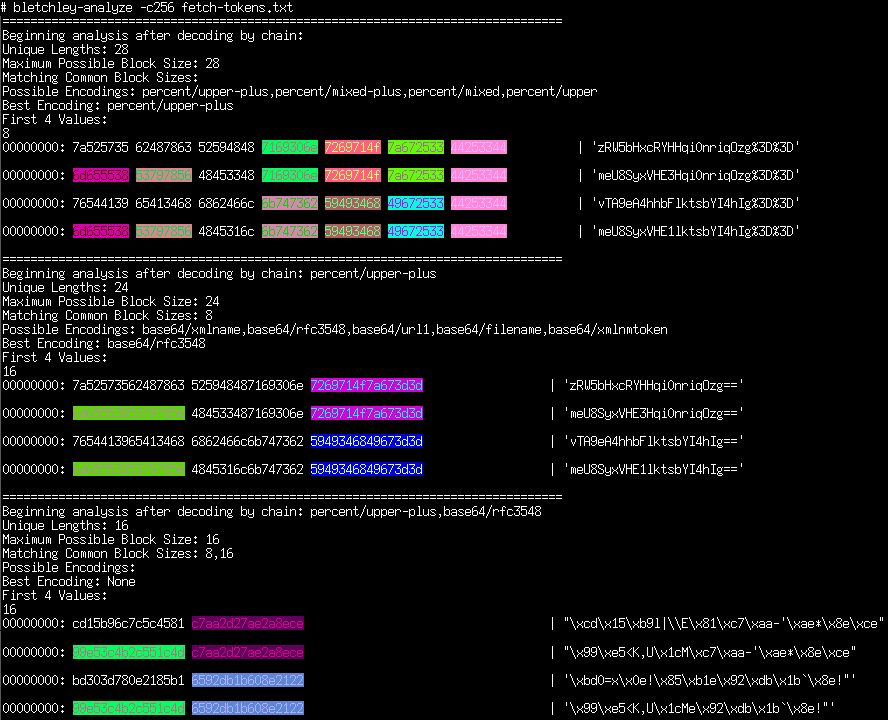Overview
Here you will find a brief overview of the tools and libraries provided by Bletchley. For further details, see the individual tool usage statements, pydoc documentation, and of course the source code.
Installation
See: INSTALL
Command Line Tools
bletchley-analyze
Analyzes samples of encrypted data in an attempt to decode samples to binary and identify patterns useful in cryptanalysis. The purpose of the tool is to provide an cryptanalyst with a variety of information that is useful in determining how a token is encoded, encrypted and formatted.
bletchley-analyze currently performs two primary functions: iterative encoding detection and ciphertext-only block analysis. Encrypted tokens are processed in multiple rounds. Within each round, the following occurs:
- Token length analysis is performed to attempt to determine possible ciphertext block sizes, where applicable
- The tokens are analyzed for blocks of data that are repeated throughout any of the tokens
- A hexadecimal dump and escaped binary/ascii string is printed for each token with repeated blocks highlighted
- The full set of all known and possible data encodings is determined1
- An educated guess is made as to the most likely encoding is
- All tokens are decoded using the most likely encoding, and then the process is repeated until no further encodings are detected
bletchley-analyze can read from stdin or from a file. Tokens are
delimited with newlines. Various options are provided to give the
analyst control over the block sizes and encoding used during analysis.
See the tool's usage statement for more information.
As an example, several tokens were encrypted using ECB mode and encoded using base64, and then percent (URL) encoded:
zRW5bHxcRYHHqi0nriqOzg%3D%3D meU8SyxVHE3Hqi0nriqOzg%3D%3D vTA9eA4hhbFlktsbYI4hIg%3D%3D meU8SyxVHE1lktsbYI4hIg%3D%3D
These tokens were then fed to bletchley-analyze:

1. Bletchley's blobtools module currently supports 36 encoding variants,
including various forms of hexadecimal, base32, base64, and percent
encodings. Try '-e ?' to list them.
bletchley-encode
A simple tool to encode arbitrary data using a specified encoding chain. See the usage statement for more information. A quick example:
$ echo 'Mallory Is My Friend.' | bletchley-encode -e percent/upper-plus,base64/rfc3548 TWFsbG9yeSBJcyBNeSBGcmllbmQuCg%3D%3D
NOTE: The encoding chain is applied from right to left in order to be consistent with other tools.
That is, one can use the same encoding chain ordering for
bletchley-encode, bletchley-decode, and bletchley-analyze.
bletchley-decode
A simple tool to decode data using a specified encoding chain. See the usage statement for more information. A quick example:
$ echo 'TWFsbG9yeSBJcyBNeSBGcmllbmQuCg%3D%3D' | bletchley-decode -e percent/upper-plus,base64/rfc3548 Mallory Is My Friend.
bletchley-http2py
This script parses an HTTP request (provided via stdin or as a text file) and generates a Python script that sends (approximately) the same request. This is useful when one wants to repeatedly send variations of a request that was observed to be sent by an application or web browser. For more information, see the script's usage statement.
bletchley-nextrand
A simple program which computes the state of a Java Random class
instance given two sequential outputs of
nextInt().
For more information, see the usage statement.
Libraries
Start with 'pydoc3 bletchley'. The following provides a brief overview of what each module is for.
blobtools
This module contains the code which handles base analysis of encrypted token encodings. It can be used to automatically detect the most likely encoding variant ("dialect") as well as to quickly encode or decode data which is wrapped in multiple levels of encodings.
buffertools
This module contains a collection of tools mean to help one manipulate binary buffers of ciphertext.
CBC
The CBC module contains various tools for attacking CBC encrypted data.
In particular, it contains the POA class which automates padding oracle
attacks. To use the POA class, one simply needs to implement a function
in Python 3 which submits a request to an oracle and returns True if the
padding check was successful and False otherwise. See
'pydoc3 bletchley.CBC.POA' for more details.
Support
Having trouble? Submit an issue here, or ask on the email list.
Contributing
We welcome any kind of help with the project, from new tools to bug fixes and documentation. You might want to start with our TODO list. To submit a patch, please post an issue or submit it to the email list and we'll merge it.
